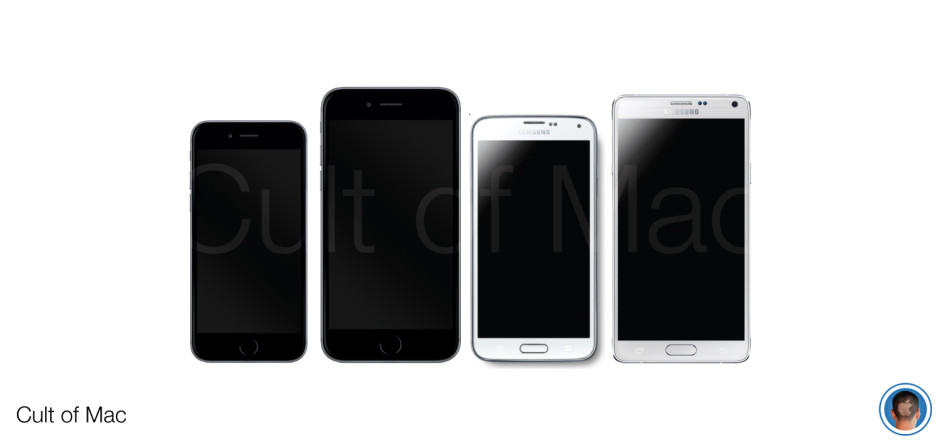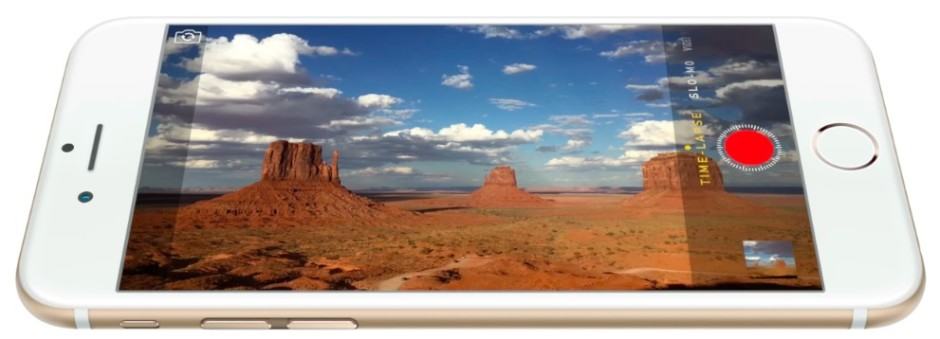Can Apple’s new iPhones best Samsung’s smartest Galaxies?

Image: Ste Smith/Cult of Mac.
Apple’s new iPhones are a big improvement over their predecessors in almost every way. Both the iPhone 6 and the iPhone 6 Plus have the larger, sharper displays loyal users have been begging for, as well as a faster A8 processor, twice as much RAM, and improved iSight cameras.
But how does the iPhone 6 stack up against the latest devices from Samsung? Check out our comparison below to see if Apple’s new baby has what it takes to beat the Galaxy S5 and the Galaxy Note 4 in a specifications smackdown.
Please scroll the table left and right to see all of its contents
| iPhone 6 | iPhone 6 Plus | Galaxy S5 | Galaxy Note 4 | |
|---|---|---|---|---|
| OS | iOS 8 | iOS 8 | Android 4.4.4 | Android 4.4.4 |
| Display | 4.7-in (1334×750) | 5.5-in (1920×1080) | 5.1-in (1920×1080) | 5.7-in (2560×1440) |
| PPI | 326 | 401 | 432 | 515 |
| CPU | 2.4GHz A8 (64-bit) | 2.4GHz A8 (64-bit) | 2.5GHz Snapdragon 801 | 2.7GHz Snapdragon 805 |
| RAM | 1GB (TBC) | 1GB (TBC) | 2GB | 3GB |
| Storage | 16GB, 64GB, 128GB | 16GB, 64GB, 128GB | 16GB, 32GB + microSD (up to 128GB) | 32GB + microSD (up to 128GB) |
| Cameras | 8MP (rear) + 1.2MP (front) | 8MP (rear) + 1.2MP (front) | 16MP (rear) + 2MP (front) | 16MP (rear) + 3.7MP (front) |
| Fingerprint | Yes | Yes | Yes | Yes |
| Other | NFC, M8 motion processor, barometer | NFC, M8 motion processor, barometer | Dust- and water-resistant, IR blaster, NFC, heart rate monitor | Dust- and water-resistant, NFC, heart rate monitor |
| Size | 138.1 x 67 x 6.9mm | 158.1 x 77.8 x 7.1mm | 142 x 72.5 x 8.1mm | 153.5 x 78.6 x 8.5mm |
| Weight | 129g | 172g | 145g | 176g |
| Battery | TBC | TBC | 2,800mAh | 3,220mAh |
Thanks to their larger displays, the new iPhones are now closer in size to Samsung’s flagship Galaxy S5, but of course, the South Korean company’s flagship phablet is still the biggest of the bunch — at least in terms of the display. The iPhone 6+ is actually biggest overall, despite an ever so slightly smaller screen.
Comparing processors is tough because although the iPhone’s A8 chip has the slowest clock speed, it’s the only one built on 64-bit architecture, and that counts for a lot. Its predecessor, the A7, was one of the most powerful mobile processors of 2013 — despite being clocked at just 1.3GHz and having only two cores.
Whichever handset you choose, though, power is pretty much guaranteed with these devices; none of them are going to stutter or struggle when multitasking, playing the latest games, or performing other processor-intensive tasks — though Samsung’s TouchWiz user interface for Android is known for being a little slow in places.

The iPhone’s camera keeps getting better. Photo: Apple.
The iPhone 6 does have what seems like a less spectacular rear-facing camera than the others, but Apple has made some major improvements to its sensor that produce even better photos. It has also added optical image stabilization to the iPhone 6 Plus. It’s also worth remembering that software plays a big part when it comes to picture quality; both the iPhone 5 and the iPhone 5s had 8-megapixel cameras like the iPhone 6, but they were capable of outperforming most of their rivals thanks to Apple’s software.
I recommend deciding how big you want your next smartphone first: iPhone 6 or Galaxy S5? iPhone 6+ or Galaxy Note 4? Then decide which operating system you’d prefer — clean and simple iOS or highly-customizable Android?


